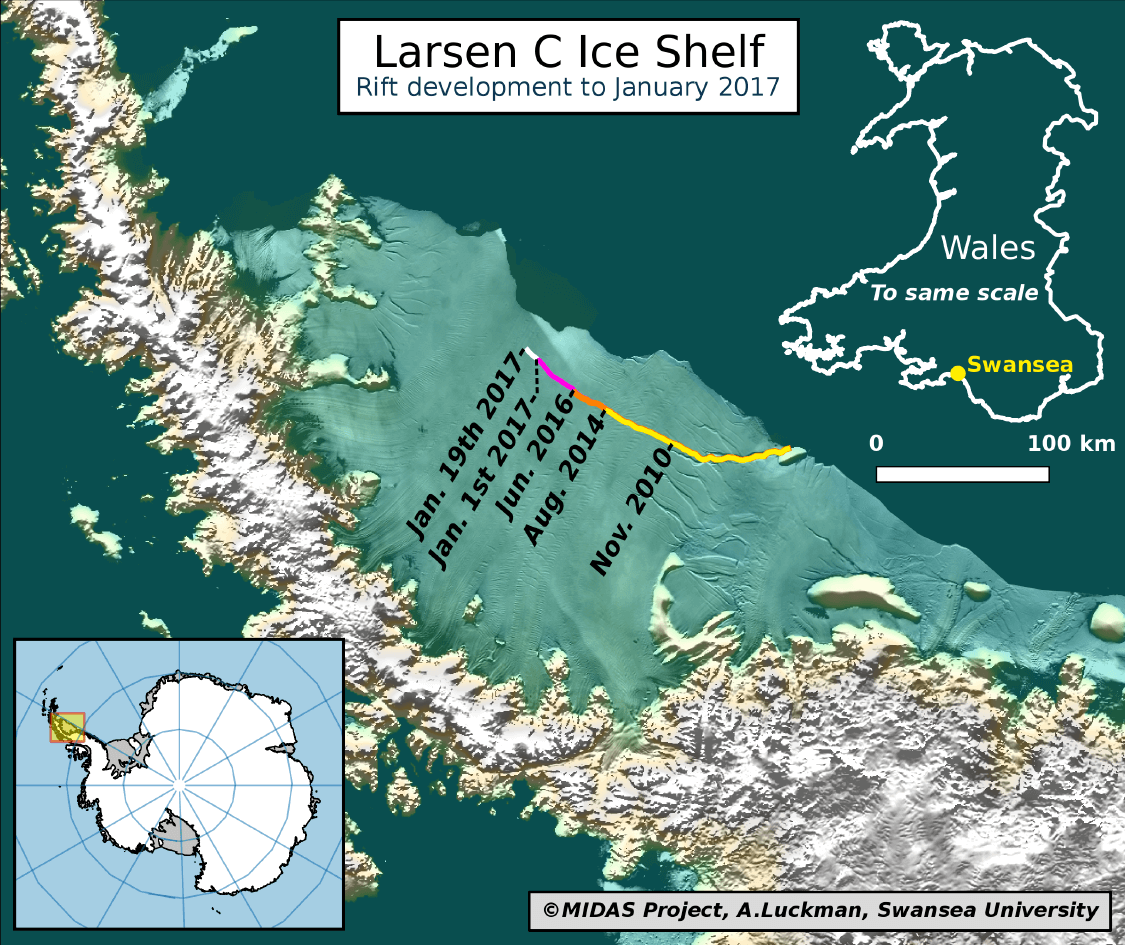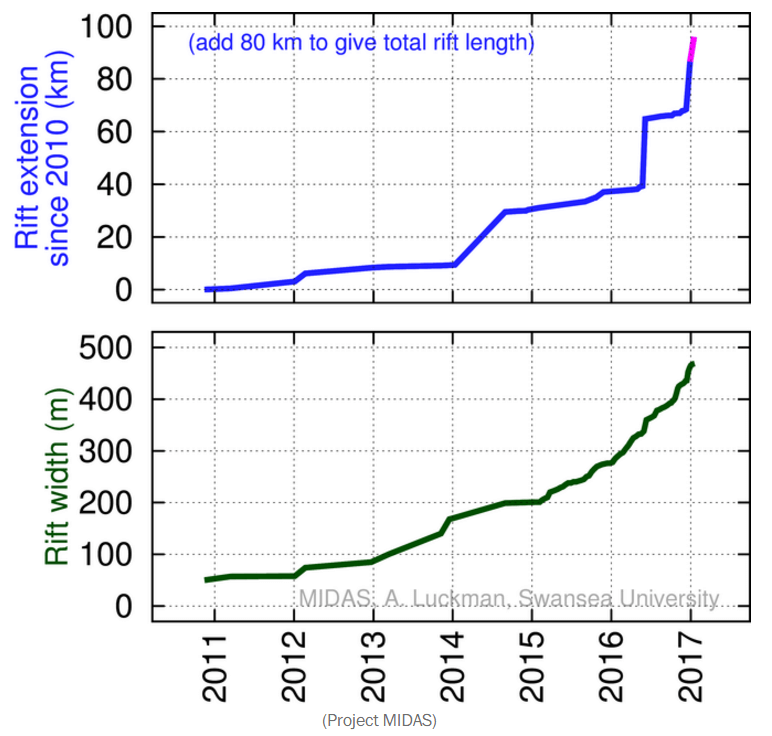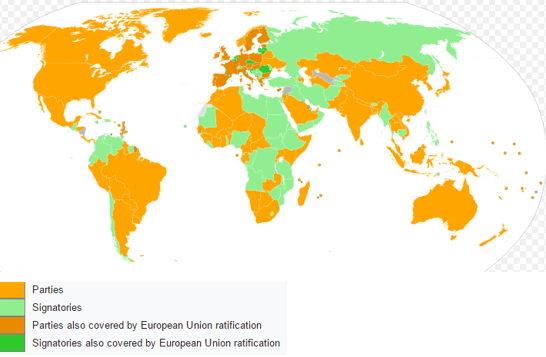Today, the Washington Post reports the Antarctic ice shelf crack has grown by almost ten kilometres (six miles) in the last two weeks. Another extension of almost eighteen kilometres (11 miles) was also reported in the last two weeks of December. It’s now more than 160 kilometres (100 miles) long.
The map below shows that the rift runs parallel with the sea-edge of the shelf. The gap between the top edge of the rift and the sea is currently around 19 kilometres (12 miles). However, the rift will likely continue to grow and if it reaches the sea, the resulting iceberg would be massive.

According to the data from the scientists, the pace of growth of both the crack’s width and length is increasing.

Stunning Drone Footage of the Crack
The area may not break off as the crack is entering a more stable area of the ice. The scientists say that means they cannot predict the outcome with any surety.
The researchers reiterated a statement they released earlier this month, signaling their suspicion that this will lead to the breakoff of a nearly Delaware-size piece of ice and “leave the ice front at its most retreated position ever recorded; this event will fundamentally change the landscape of the Antarctic Peninsula.” They fear that the break could speed up the flow of the ice seaward and potentially destabilize the shelf, which holds back enough ice above sea level to raise oceans by 4 inches [ten centimetres]. But not every scientist agrees that will be the outcome. …
“Every advance would seem to bring the end closer,” said Adrian Luckman, a researcher with Swansea University who heads up the project.
“However,” Luckman continued, “the rift has now entered the softer suture zone ice originating from Cole Peninsula, which we believe to be more substantial than elsewhere, so it is still impossible to make predictions.”
Whatever happens, there is no doubt that the crack is caused by global warming. And, if temperatures continue to rise, the area of ice will break off.
2016 Warmest Year on Record
Yesterday, NASA announced that 2016 was the warmest year on record globally:
Earth’s 2016 surface temperatures were the warmest since modern recordkeeping began in 1880, according to independent analyses by NASA and the National Oceanic and Atmospheric Administration (NOAA).
Globally-averaged temperatures in 2016 were 1.78 degrees Fahrenheit (0.99 degrees Celsius) warmer than the mid-20th century mean. This makes 2016 the third year in a row to set a new record for global average surface temperatures.
The 2016 temperatures continue a long-term warming trend, according to analyses by scientists at NASA’s Goddard Institute for Space Studies (GISS) in New York. NOAA scientists concur with the finding that 2016 was the warmest year on record based on separate, independent analyses of the data.
The Paris Accord
It continues to be of vital importance that we do all we can to mitigate the effects of climate change. The Paris Accord, signed by almost every country in the world, will go a long way towards that. It was only able to be signed because President Obama brought the biggest emitter to the table. This was celebrated worldwide after years of the United States avoiding their responsibilities.
World leaders are now extremely angry due to the comments president-elect Trump is making regarding climate change. Especially, they are upset at his threats to withdraw from the Paris Accord. Some are apparently considering a carbon tariff on US goods. The Accord is not legally binding in any effective way so he can effectively ignore it. Further, if the US does not abide by their promises, there is a high risk some others won’t either.
If president-elect Trump fails to meet his country’s obligations under the Paris Accord, Delaware-sized icebergs could become commonplace.
If you enjoyed reading this post, please consider donating a dollar or two to help keep the site going. Thank you.


Great footage of the crack. With the amount of data available, the only way to deny the warming and the fact of human causation would be to shut down ones rationality in response to buckets full of cash from big oil.
I’ve long thought carbon tariffs will become necessary for laggards like the US (and NZ). If they won’t price in this pollution themselves, the more responsible countries will have to do it for them.
Shortly after the election debacle here in the “Land of the Stupid”, I opined to some friends that The Sociopath was going to pull us out of the Paris accord and the result would be: China, being acutely aware of the dangers of pollution in general, and being well positioned to overtake the US as the largest economy in the world, would then take the lead (that the US had) and rally the rest of the world to take action. The rest of the world would then impose a carbon tax on countries not complying with agreed upon standards and strongly punish the US for being such assholes. We’ll have to see what happens. “May you live in interesting times” is gaining new meaning every day.
The last NZ prime minister (he resigned a few weeks ago) announced at a Pacific leaders meeting at the end of last year that if the US pulled out of TPP, there would be a gap waiting to be filled, and China would do it.
The whole idea of TPP was partly about the US pivot to the Asia-Pacific region, which is becoming the economic powerhouse of the world.
I agree, though with NZ the fact that half of our emissions are methane from animals makes it difficult. We do need to do more in other areas though.
Yes, agriculture is harder, but NZ currently uses that as an excuse, which is not surprising given the govt’s position is to appear to be acting, while doing as little as possible. There is more we can reasonably do across the board. The world knows we have an unusual emissions profile. That isn’t the barrier to a meaningful policy, lack of good faith is.
An important, interesting and worrying post. I have shared it as widely as I can.
Thank you. 🙂